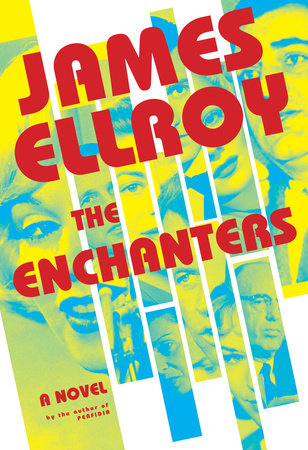This over-the-top potboiler may be too much for all but the author’s diehard fans.

When we last saw disgraced cop Freddy Otash, author James Ellroy’s rogue literary alter ego, his body was six feet under and his soul was deep in purgatory, plotting a way out. That was two years ago in Widespread Panic. Now, with The Enchanters, Ellroy has written a prequel of sorts, beginning with Otash’s October 1992 graveside service and flashing back to the events that earned him a seat in hell’s waiting room.
The action starts in Los Angeles on August 4, 1962, when Otash is recalled into freelance law-enforcement service by Police Chief Bill Parker to solve the kidnaping of a B-movie actress who happens to be the mistress of 20th Century Fox mogul Darryl Zanuck. When strong-arm methods against the perpetrator fail to yield a confession, Otash tosses him 80 feet off a cliff and onto a freeway.
Before meeting his maker, the doomed snatcher screams, “It’s a put-up job,” setting the wheels of another of Ellroy’s violent, dirty-cop misadventures in motion. Admittedly, Ellroy is an acquired taste. His alliterative melding of fact, fiction, and unfettered imagination requires from readers a tolerance for sex-charged language, excessive violence, and political incorrectness.
For film buffs, August 4, 1962, is among the most infamous dates in cinema history; it’s the day 36-year-old Marilyn Monroe overdosed in her Brentwood home. Because her suicide is the centerpiece of the novel, it’s no surprise the Kennedy brothers, their sister Patricia Kennedy Lawford, her husband (the actor Peter Lawford), and Jimmy Hoffa show up in its pages. Added to the mix are stars and star-wannabes from midcentury Hollywood: Liz Taylor, Richard Burton, Eddie Fisher, Los Angeles Angels’ pitcher “Bo” Belinsky, Rex Harrison, and the doomed precursor to Monroe’s place in the celluloid world, Carole Landis, who killed herself in 1948 after her lover, Harrison, refused to leave his wife.
(These characters are “the enchanters” of the book’s title, and Ellroy includes a directory of them and a glossary of police jargon, the most helpful entry being the definition of “459,” the California Penal Code section for burglary.)
Once again, Otash finds spiritual comfort in his chaste love affair with actress Lois Nettleton. Simultaneously, he enjoys a more carnal liaison with unhappy Pat Lawford. The premise is preposterous, and for Ellroy fans who recall the beautifully crafted plots of L.A. Confidential and The Black Dahlia, this book will be disappointing.
Otash’s throwing of the suspected kidnapper to his death was supposed to be hush-hush, but everyone in the story — from the Hollywood drive-in waitress on roller skates to Attorney General Robert F. Kennedy — seems to know he did it. Now, he must perform penance by doing dirty work, and in Ellroy’s world, there’s always plenty of that to do.
Like the old “Spy vs. Spy” cartoon in Mad Magazine, the main characters are busy wiretapping, tailing, photographing, and conducting home break-ins on one another. Months before Monroe’s death, Hoffa had hired Otash to find evidence that would nail the Kennedys for hanky-panky involving the troubled actress. After her suicide, RFK hires Otash to cover up whatever evidence he’d found linking Monroe to the Kennedys. Meanwhile, LAPD chief Parker, who was promised the job of FBI director in a second John F. Kennedy administration, conscripts Otash to dig up a scandal to hold over the attorney general’s head in case he reneges on the deal.
Ellroy is at his descriptive best when describing the nitty-gritty of Otash’s police work. On robbing a drug-dealer’s safe with another cop:
“We decided to blow it and split the contents. He planned to donate his cut to the Free Cuba Committee. I planned to stick my cut up my nose.”
And on shooting a suspect:
“I fired point-blank. I blew his mouth and his neck cords out. A severed ear flew…I powder-scorched his eyes down to the sockets. Muzzle flash set his hair aflame.”
The denouement goes well beyond revealing whatever connection Monroe may have had to the Kennedys. Instead, it involves a convoluted history of old Hollywood that includes Monroe’s early days in a foster home, a child from that home who is murdered, and Monroe and other starlets doing stints as call-girls before hitting it big.
By the time she’s under surveillance by Otash, Monroe is no longer a superstar but instead a sad, drug-addled, mentally ill alcoholic involved in a drug-running scheme to Mexico and a hare-brained plot to take over Fox studios and become first lady once JFK divorces Jackie. But another infamous date in history isn’t far off — November 22, 1963 — after which none of this nonsense will matter.
Diane Kiesel is a judge of the Supreme Court of New York. A former journalist, she is the author of Domestic Violence: Law, Policy, and Practice and She Can Bring Us Home: Dr. Dorothy Boulding Ferebee, Civil Rights Pioneer. She is currently at work on The Trials of Charlie Chaplin, to be published next September by the University of Michigan Press.
_1_80_119.png)